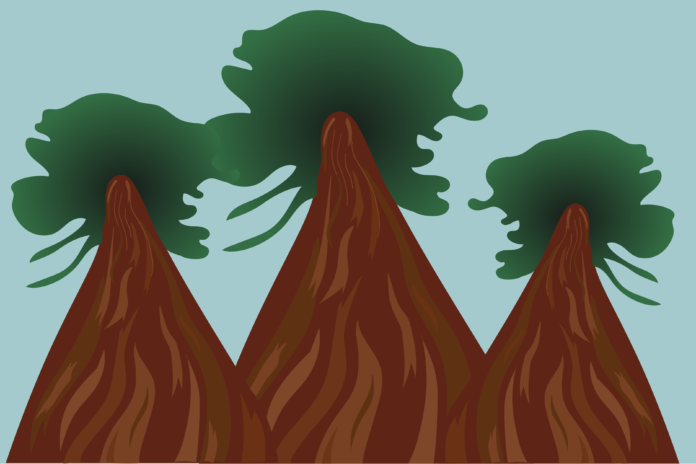Physical features like thick bark, tall crowns helped redwoods survive fire in California’s oldest state park
Firefighters have made great strides in containing the SCU, LNU and CZU complex fires, but Californians face a new challenge: returning to burned areas and processing the destruction of homes, infrastructure and outdoor spaces in their communities. For those fond of the Santa Cruz mountains, this means coming to terms with the widespread damage at Big Basin State Park, a historic site full of towering redwoods and views of the Pacific Ocean.
The historical buildings that burned down in the fire included the park headquarters and the main lodge. Many other essential buildings like the ranger station, park residencies and campground bathrooms were also destroyed. The wastewater plant for the park did survive, whose “continued functionality is an essential element to rebuilding the park in the future,” according to a California State Parks news release.
As for the park’s treasured coast redwoods, some of which are between 1,000 and 2,500 years old, the extent of the damage remains uncertain. On Aug. 28, the California State Park System announced that the Father of the Forest and the Mother of the Forest, the two largest trees in the park, appear generally healthy, but that the fire damage to other older redwoods is varied.
“Old-growth stands in the vicinity of the entrance road and lower campgrounds appear to have experienced a range of fire intensities, with the upper crowns of some trees burned while other trees remained unburned,” the press release read. “Additional assessments still need to be done to understand the health of these trees.”
Many still remain hopeful for the recovery of these trees, as coast redwoods are known for being fire-resistant and very durable. Malcolm North, a research scientist with the National Forest Service and associate professor in the department of plant sciences, described how the coast redwood’s bark is built to protect the tree from forest fires.
“They have very thick bark once they get to a reasonable size,” North said. “Like any tree, when they’re below about 25 years old or so, they’re pretty sensitive to fire. Particularly, the larger and older the tree gets, it develops a really thick bark which insulates it very well.”
He added that the coast redwood’s incredible height is a benefit to the tree in these situations.
“Coast redwood is the tallest tree in the world,” North said. “It tends to lose it’s lower limbs as it gets taller which gives it a good separation from the flames burning on the surface of the ground.”
Andrew Latimer, a professor in the department of plant sciences, mentioned that a redwood’s survival is also dependent on how high the fire burns into the canopy. If the fire has not reached the crown of a redwood, the tree has a pretty good chance of survival; even if the fire does reach that high, redwoods are able to resprout from their base.
“It depends on how intense the fire is,” Latimer says. “In some cases, fire will reach up into the crowns of redwoods and burn off all their leaves. Typically what happens in a really intense fire like that, the main stem dies but the redwoods are able to resprout from their base, so the old trunk will be dead and a bunch of new trees will sprout around it.”
Though coast redwoods have physical and adaptive features to resist fires, the redwood trees in some Californian systems benefit from occasional fires. North noted that fires can kill other less fire-resistant vegetation, which reduces the competition for resources, and can reduce foliage that fuels more intense fires.
“If you don’t thin out the smaller trees, eventually they can grow tall enough to become ladder fuels, which means the fire leaps from the surface into smaller or intermediate trees that then literally ladders up into the crown and the overstory of the tree,” North said. “At that point, even a redwood or a giant sequoia may be killed by the fire because burning the overstory crown of the tree can often be lethal.”
According to Latimer, two causes of high-intensity fires are the availability and build-up of fuel in the forest, and longer fire seasons in California that create dry conditions primed for fire—the latter of which can be linked to changing temperatures due to climate change.
“Overall in California’s forested environments, there is an interaction between fuel build-up from past land use practices—fire suppression, planting trees densely, logging the big trees—that produces these high fuel loads and continuous fuel conditions that carry fire well,” Latimer said. “With longer fire seasons—longer periods of time when the fuels are dry enough to carry a fire—those two things together lead to bigger fires, more of them, and fires that in some places burn more intensely than they did in the past.”
Though the link between fuel build-up and more intense fires is unclear in some California ecosystems, California is working to increase the number of prescribed burns in areas that benefit from them during favorable weather conditions. Several U.S. National Forests in the Sierra Nevada Mountains have begun adopting policies encouraging prescribed burns and allowing fires that have started in isolated areas to burn naturally without immediate extinguishment.
While officials work to better manage fires throughout the state, the California Park Service noted that though the immediate future of some coast redwoods at Big Basin remains uncertain, the trees are truly resilient.
“Even trees that look completely incinerated can recover fully, given time,” the press release read.
Written by: Madeleine Payne — science@theaggie.org




